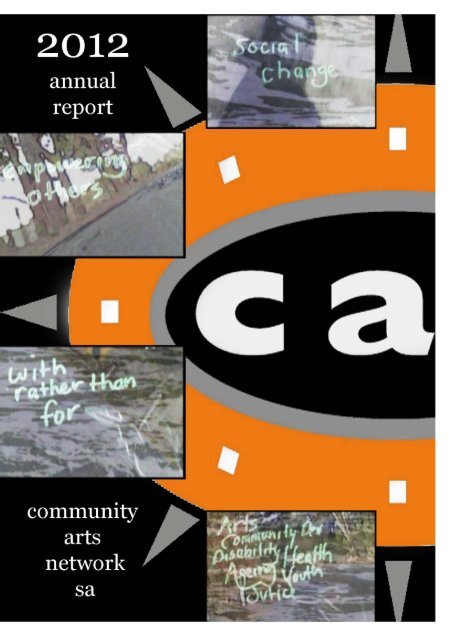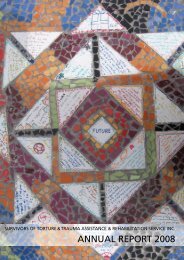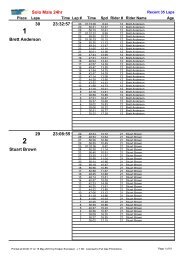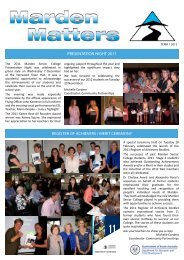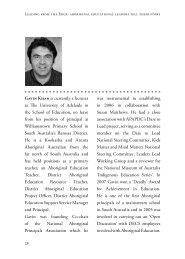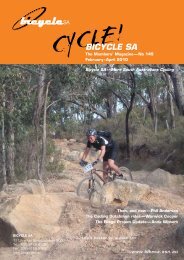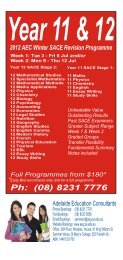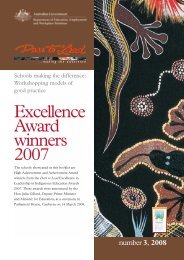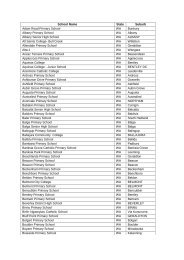You also want an ePaper? Increase the reach of your titles
YUMPU automatically turns print PDFs into web optimized ePapers that Google loves.
From the ChairDirectors SummaryGovernanceVision & MissionHuman ResourcesMembershipAdvocacyInitiativesCross Sector Committee WorkCAN SA TrainingPlaceMakingDattFinancial <strong>Report</strong>
Directors SummaryThe rollercoaster ride that is maintaining financial support for CAN SA continued in <strong>2012</strong>.We started the year with a one year extension of our multi-year agreements with bothstate and federal arts funding agencies – thankyou to both funding bodies - but we finishedin the most difficult position that CAN SA has found itself in from its inception in June 1980.Changes in priority at the Community Partnerships section of the Australia Council hasmeant that it is the first time since the early years that we start 2013 with no federalsupport. It is hard to disassociate from the precarious position we found ourselves in at theend of the year but I must so I can do justice to all the good work that has been undertakenduring <strong>2012</strong>.We started <strong>2012</strong> with a beginning of year celebration. The black and white balloons werehuge as was the spirit of the 70+ CAN members and friends that helped us kick start theyear.We thoroughlyenjoyed having thestaff and artists withus and we wish themall the best for thefuture.CAN SA membership continued to build during <strong>2012</strong> although the tight financialcircumstance of many we work with still translates through to our largest area of growthbeing in our free Friends category. Of note also is the number of people accessing usthrough social media. Our Members + Insurance category which gives community artistsaccess to public liability insurance cover at a reduced priced, also continues to grow.Both our major programs were changing during <strong>2012</strong>. Our Disability Arts Transition Team(DATT) were preparing their transition from a program of CAN SA to an organisation of theirown. By the end of the year Access 2 Arts was incorporated. We thoroughly enjoyed havingthe staff and artists with us and we wish them all the best for the future.PlaceMaking Program has been with us over a similar timeframe as DATT. Many of theorganisations that work with homeless people that have been partners with us in thePlaceMaking program are now “doing it themselves”. Our funding in this area has nowshifted beyond working with Homeless and from 2013 will become part of our ArtsProgram.International highlights for <strong>2012</strong> were the culmination of our work with fledgling group CCDSingapore that resulted in their Singapore CCD Symposium called Practices and Possibilities.After a number of years relationship building we also have permission to explore whetherAdelaide is willing and able to be the host city for the International Social Theory Politicsand the Arts conference in 2015.CAN SA continued diversifying its income streams in all areas this year with a number ofsmall arts and non-arts grants. Sponsorships still play a small but important role for CANSA. We would like to thank both Guardian Insurance and Frances Sheppardfrom BeeCos Business Software for their ongoing support.I would like to thank CAN SA staff, Board, members, friends, partners,funders and sponsors for their support this year.CheersLisa Philip-Harbutt (Director)
GovernanceIt is CAN SA’s Board of Management that is ultimately responsible for the governance of the organisation. TheBoard is made up of dedicated and committed people drawn from the membership who give their time voluntarily.Their contributions to the organisation are highly valued. Should any members be interested in joining our Board ofManagement we would encourage them to join our Prospective Board members list.In <strong>2012</strong> the members of the CAN SA Board were:Christine Putland (Chair)Christine is a Consultant: Arts and Health research and has a background in community arts coordination, teaching,training , research and evaluation.Helen Crawford (Treasurer)Helen is a community arts worker who has experience in visual arts education, admin/management.Nick Hughes (Secretary)Nick is the Company Manager of Restless Dance Theatre and has a lifetime working in community arts, in theatre,as a writer, actor and Artistic Director.Bob DalyBob is a freelance artswoker in ccd and has worked nationally and internationally; he is also the secretary of thePort Adelaide Artists Forum.Ruth SmilesRuth is a consultant with a vast knowledge in training, policy, ccd and strategic planning.Robert PetchellRobert is a Freelance Composer, Music Director and Arts Project ManagerKirstie JamiesonKirstie is an Arts Worker and is the Arts and Cultural Development Manager for Country Arts SA.Steph KeySteph is a founding member of the Trade Union Choir (SA) and has been involved in various community and unionarts projects. Steph is also a Member of State Parliament.Lawrence Wilkes (Finished on the Board May <strong>2012</strong>)Lawrence has collaborated on and co-ordinated many community arts projects, murals, mosaics, animation andhas taught soft stone sculpturing.Lisa Philip-Harbutt (Director)Lisa has spent over 30 years playing in the crossovers between performing, visual and community arts. She hasbeen Director of CAN SA since 2003 but still makes art whenever she can.Jo Ankor (Staff Member on the Board)Jo is the Sector Development Officer at CAN SA and is a Doctor of Philosophy, a lecturer and consultant in CulturalTourism and Festival Event Management.
Human ResourcesA BIG thankyou toeveryone whoattended workshops,events, parties etcduring <strong>2012</strong>, yourcontinued supportand interest inspiresand directs us.CAN SA has always prided itself on being a flexible workplace which offers staff theopportunity to have work/life or work/arts practice balance. CAN SA is committed toproviding high quality programs and services to its members and the community, and tosupport the achievement of this objective CAN SA recognises the importance of employingthe most suitable applicant for all vacant positions. Staff are recruited without regard togender, age, disability or racial background. The sole qualification for staff recruitment issuitability to perform a task on behalf of the organisation. During <strong>2012</strong> CAN SA was able toachieve some amazing outcomes through the incredible diversity and commitment from itsstaff, contract workers, artists, writers, guest speakers, advisory group members, accessworkers, consultants and volunteers which included:Lisa Philip-Harbutt, Kath Davis, Dr Jo Ankor, Kate Moskwa, Susan Williams, Helen Bock,Gaelle Mellis, Martin Sawtell, Cameron Bache, Carmel Batson, Jayne Boase, KirstyMartinson, Irene Dougan, Christine Doolan Jacques, Chrissie Evans, Raylene Snow, VickiRich, Mark Finlay, Navian Isuet, Chandler Giles, Jeremy Urquhart, Merv Hume, HelenCrawford, Jennifer Taylor, Lawrence Wilkes, Heather Frahn, Michael Newbold, Stuart Rose,Steve Glass, Corey Stewart, Indigo Eli, Anna McLean, Mark Finlay, Michele Fairbairn, SandyElverd, Kaz Pederson, Sarah Van der Sommen, Lucy Thurley, Sam Finlay, Amber Venner,Catherine Oates, Ad’m Martin, Dr Jo Caust, Jo MacDonald, Christine Putland, BradThomson, Eliza Lovell, Jane Andrews, Dr Catherine Grant, Ross Onley-Zerkel, JoanneDunbar, Andrew Follows, Becky Llewellyn, James Kurtze, Jennifer Greer Holmes, Sam Oster,Jacek Limanowka, Sophia Borick, Luna Parish, Wendy Todd, Pip Cody, Sally Chance, LauraWills, Diwani Oaks, Lara Torr, Sophia Borick, Stephen Noonan, Sam McMahon, MatthewIves, Sasha Grbich, Bill Shannon, De Brown, Chelsea Turner, Leigh Russell, Elisha Jackson,Matt Shilcock, Adrienne White, James and Sandra Hopper, Tanya Chaplin, Sarah Leitner,Carol Wellman Kelly,Lucia Van Sebille, Susie Fraser, Bindi Blancher, Violet Cooper, SusieChapman, Lorry Wedding-Marchioro, Sue Morley, Annie Fox, Helen Kavanagh, John Nieddu,MT, Michael Gunn, Sophie Winzar, Lynly Cooper, Peter Lindon, Helen Carmichael, BridgetteMinuzzo, Derek Curtis-Rogers and Nicola Haywood.Kate Moskwa, Cameron Bache, Susan Williams, Martin Sawtell, Jo Ankor, Lisa Philip-Harbutt, Helen Bock & Kath Davis
Lisa Philip-Harbutt, Kate Moskwa, Helen Bock, Jayne Boase,Jo Ankor, Cameron Bache & Susan WilliamsKath Davis, Jo Ankor, Cameron Bache,Helen Bock & Carmel BatsonA BIG thankyou to everyone who attended workshops, events, parties etc during <strong>2012</strong>, yourcontinued support and interest inspires and directs us. We would also like to say a bigthankyou to EVERYONE who has worked with CAN SA in some way during <strong>2012</strong> including allthe participants from all the wonderful <strong>2012</strong> PlaceMaking projects, the Richard LlewellynArts and Disability Trust auspiced artists and all the participants from the <strong>2012</strong> DATT andCAD workshops. We apologise if we have inadvertently left anyone out.MembershipCAN SA is committed to continual improvement and during <strong>2012</strong> we again focused on howwe share information and manage our databases and membership services. Membershipservices include the Bulletin newsletter which contains industry news, CAN SA news,employment opportunities, funding opportunities, professional development and a guideto what’s on in the Arts and Community Sectors and also the information sharing Broadcastemails. Those accessing our membership services are also encouraged to take advantage ofthe wealth of knowledge within the CAN SA staff through consults. During <strong>2012</strong> weengaged with 889 members/friends/subsrcibers who accessed our services and informationsharing. This figure consists of 238 members, 291 Friends and 360 MailChimp Friends. Wecommenced the Members+ Insurance package back in 2008 with 9 members and in <strong>2012</strong> ithas grown to now insure 61 artists and artsworkers. This increase in the amount of artistsand artsworkers who have taken up the coverage over the last 5 years has been fantastic asof course the more people who join means the more leverage we have in keeping thepolicy costs down.We commencedthe Members+Insurance packageback in 2008 with 9members and in<strong>2012</strong> it has grownto now insure 61artists andartsworkers.In <strong>2012</strong> we sent 19 informative MailChimp Broadcast emails plus other quick response onesand we are happy to say we had an average open rate for the emails of 48.8% - which is upon the average of 41.2% from 2011 (FYI the average open rate for emails throughMailChimp for the Arts and Artist’s Industry was 24.2% in <strong>2012</strong>). We also published 10 newlook Bulletins throughout <strong>2012</strong> all containing inspiring and stimulating information andimages throughout them. Thankyou to Guardian Insurance Brokers for their sponsorship ofprinting - every bit helps. Our Facebook Page has 265 Likes. While we are still fairly quieton the Twitter front we do have 26 followers, tweeted 22 times and we enjoy followingover 50 other twitter accounts; stick with us as we develop this side of our online profile.
Arts, culture & resilience - an ongoing conversationIn 2011 Community Arts Network SA published an Artwork Journal called “arts, culture and resilience” whereacademics and arts practitioners from across Australia responded to English researcher and writer Mark Robinson’s2010 paper for the Arts Council England, “Making Adaptive Resilience Real”. At the Kumuwuki / Big Wave RegionalArts conference in October <strong>2012</strong> there was a great opportunity to pick up the conversation where the ArtworkJournal left off. This important discussion involved an expert panel of Mark Robison, Julia Anwar McHenry, CathyHunt and Nick Hughes. They reflected upon their own situations in relation to the views articulated in the twojournals. Lisa Philip-Harbutt chaired the session over the Internet from Baton Rouge, USA, with support fromChristine Putland when the technology caused a few concerns.South Australian Council of Social Services (SACOSS) state conferenceHelen Bock was invited to be part of a panel presentation at the SACOSS state conference. The topic which we wereinvited to speak to was ‘Community Development at work in the Arts’. We explored the following questions… What is it about arts projects that lend themselves to Community Development? Do arts projects promote inclusion past the length of the project? What can the sector learn from the Arts?Session Co-Presenters: Matthew Ives, Emma Webb, Lenore de la Perrelle.Mention in Arts Leadership BookIn <strong>2012</strong> Jo Caust edited a Tide University Press book called Arts Leadership: International Case Studies. It is anedited collection of international case studies discussing approaches to arts leadership and management. Shebelieves that over the past decade, approaches to leadership and management in the arts have changed toaccommodate many environmental and social issues. CAN SA’s Director was selected and interviewed for this bookand a section on her leadership style appears in Chapter 13 - Thriving or surviving: Artists as leaders of smaller artsorganisations.Arts Activated ConferenceDATT staff members were invited to present at Accessible Arts - Arts Activated Conference. Katharine Annear joinedthree other prominent thinkers: Emma Bennison, Arts Access Australia, Morwenna Collett, Australia Council andDavid Kay, KPMG, to discuss Vision for Arts and Disability in Australia. Katherine spoke about disabled led work andsupporting education and emerging aesthetic which was very well received and provoked much thought byattendees. Katherine also chaired and summarised the session Artists: Unlimited UK. Martin Sawtell presented atthe Venues: Inclusive Practice session using DATT’s blind and vision impaired exhibition rarely seen as a case studyfor inclusive practice. Gaelle Mellis and Kath Duncan were to present ‘Artists: Compromises and considerations -Global Travel Beyond the Social Model’. However, in response to day one of the conference and requests fromartists, they changed their session to hold a meeting for Deaf and disabled artists to facilitate meeting, networkingand the formation of a national network for and by people with disability. Gaelle also chaired ‘Disability/CommunityProjects: Disability-led projects’.Throughout <strong>2012</strong> CAN SA was also active in advocating for more community arts and cultural development practiceto a wide range of audiences. CAN SA staff members have delivered “intro to community arts” and “intro to CCD”in a range of different settings from tertiary educational institutions to local government support services, from non-arts service organisations to small community groups.
Arts Access Australia Members MeetingAs well as attending Arts Access Australia’s (AAA) members meeting, Martin and Gaelle were invited to present onthe ‘Shots in the Dark’ project and audio description services being developed by DATT in South Australia. AAA alsoused this meeting day to start developing Australian standards for audio description in which DATT plays a vital rolebecause South Australia is developing the first professional live audio description service in Australia.InitiativesHealing GardenThe aim of this project was for Aboriginal community members to engage in a meaningful process for the creation,ongoing development and use of the Stolen Generations Healing Garden. This grassroots project, conceived as aCircle of Hope and driven by two local Aboriginal women, Ms Christine Jacques and Ms Chrissy Evans, both StolenGenerations survivors, has the potential to be part of a healing journey for many. Their journey started with theirattendance at the national Apology and they see the development of the park as a local and lasting expression ofthis occasion. They envisage the Stolen Generations Healing Garden as a local acknowledgment of the StolenGenerations experience which touched the lives and was keenly felt by many people, black and white, in NorthernAdelaide: those who were taken, and those who took children in. Sections of the garden may also be blessed bytraditional healers giving access to old ways and to bush tucker and medicine. Together with fellow members ofthe local Aboriginal community, they seek to educate and inform Aboriginal youth and the wider community aboutthe shared legacy of past policies. Cultural practice occurring in a safe and creative environment is a healingexperience that has the potential to both reclaim lost culture and identity as well as build new connections andnew cultural traditions.This project idea had been sustained by the community for four years when CAN SA was asked to contribute tomoving the idea into reality. The project has now been divided into a series of stages:Stage 1 – Community exploration of topic and siteStage 2 – Establishment of Community governance; development and installation of circles of hope; and the writingof brief for memorial sculptureStage 3 - Commissioning of memorial sculpture and celebration of project with wider community.As this is a low socio-economic community CAN SA targeted key supporters and funding opportunities for eachstage. Funds for Stage 1 and Stage 2 were sought and achieved. $10,000 was found through support from FAHCSIAvia Playford Council and Office for the Arts ICS program has committed $30,000 for Stage 2 to pay for projectco-ordinator, community arts workers, support workers, trainers, workshop venue, materials, installation costs anda small administration fee for servicing the grant.Community Arts Network SA has a policy to only work in partnership with locals with the aim of empoweringparticipants and leaving skills behind when the project finishes to enable the prospect of future projects run locally.The Partners thus far have been local community, Playford Council, Urban and Regional Strategy – NorthernAdelaide Initiative and Marra Dreaming. Late in <strong>2012</strong> the Healing Garden women along with staff from MarraDreaming were involved in hiring a Healing Garden Project Officer, Irene Dougan.
Images from Say, Show, ShareSay, Show, Share,On Friday 21 September <strong>2012</strong>, we hostedthe inaugural Say, Show, Share event atCAN SA. The concept of the project was toconnect artists with employmentopportunities. It was also to introducedifferent artists and their broad practicesto arts and cultural workers at localcouncils so that partnerships could bemade.The project consisted of two parts; a workshop and presentation session. The workshopwas to up-skill artists in presenting their community arts practice. The event, a quickpresentation style in which presenters were invited to talk to 15 slides, for 20 seconds perslide, a total of 5 minutes per person. The idea was to make the presentation short, sharp,and shiny - and to say, show and share community artists’ practice to a room full ofpotential employers. The audience was predominantly members of the CreativeCommunities Network, a group of Arts and Cultural Officers working across South Australiain local government. This format was challenging but kept presentations quick andconcise - important for the audience, and a great skill to learn!The event was also in the program for PLACE <strong>2012</strong> which is in its first year as a platform toprovoke deep exploration, conversation and discussion about our sense of place. Artistspresented to local council on their experiences of making art in and for the public realm.Tea cosy ProjectCAN SA staff have been supporting Uniting Communities staff on the development of theirtea cosy project. Stage 1 of this project is seeing the transformation of a 50’s style caravaninto a giant teapot which will be visiting isolated older people in community during 2013.Stage 2 of the project is a large community arts project to give this giant teapot a tea cosy.The concept of theproject was toconnect artists withemploymentopportunities … tointroduce differentartists and theirbroad practices toarts and culturalworkers ...
Images from Arts and Health: Healthy Communities through Arts Engagement(partner organisations - Ink Pots Arts and District Council of Mt Barker)PlaceMaking projectswork on the beliefthat meaningfulinteractions can turnspaces we findourselves in, intoplaces we want toengage with. Artworkshops arewonderful ways forpeople to havemeaningfulinteractions.Performing Arts and Social Activism: using street theatre as a vehicle forsocial commentPartner Organisation - Senior Ensemble Urban Myth Youth Theatre. This 3-day workshopseries was been deferred to late January 2013 to fit in with the Senior Ensemble’s commitments.Helen Bock and Stephen Noonan will work with the group of emerging theatre performerswho have expressed appreciation for the chance to learn, consider and understandthe issues and details of street theatre practice associated with making public social comment.PlaceMakingPlaceMaking projects work on the belief that meaningful interactions can turn spaces wefind ourselves in, into places we want to engage with. Art workshops are wonderful ways forpeople to have meaningful interactions.CAN SA - PlaceMaking Project works with people who have experienced homelessness, artsworkers, community organisations and government agencies to act creatively in the pursuitof making connections for low income and homeless people into their community.PlaceMaking works with communities to explorethe social, cultural, environmental,financial and economic dimensions of their lives.We have been working in creative ways withcommunities to stimulate new skills and createphysical and /or human reminders of communityinteraction. In <strong>2012</strong> projects were undertakenwith – Unity Housing, Hutt Street Centre, WestcareKarpandi Arts Centre and St Bede’s Anglican ParishSemaphore. This was our final year of deliveringPlaceMaking projects which were assisted throughAustralia Council funding.Image from Courtyard Project
Courtyard ProjectHutt Street Centre – The courtyard, at the back of theCentre, was identified as a space to work on. With a changein ‘No Smoking’ areas introduced at the Centre, thecourtyard was becoming a redundant space to clients.Lawrence Wilkes & Helen Crawford worked with clients todesign ways for the courtyard to be more comfortable &appealing. The artists worked with the clients and didImage from Courtyard ProjectMosaics on all the outside tables, murals on garden sheds andpainted and decorated all the outside seating. To launch and celebrate the work, the cookdecided to do lunch in the courtyard and has since scheduled lunch in the courtyard as aregular procedure.Front Planter BoxesPlanter boxes to grow fresh food were part of an Adelaide City Council initiative which HuttSt Centre was invited to be part of. Steve Glass – aerosol artist – worked with some of theclients to design and paint the planter boxes. The workshops held at the Hutt Street Centrewere engaging and fun for all involved. The participants shared many personal experienceswith the artists. Stories were told, information and knowledge shared, friendshipsdeveloped, and confidence gained.Glass WorkshopsUnity Housing - Gilles St Lodge is an ex YHA premise which has been converted into aboarding house for homeless women. We ran glass workshops with Jennifer Taylor (artist).Several pieces of glass work were made by individuals. The idea was to work informally inthe common spaces and hopefully build on possible ideas and activities to do next in thelodge. Unfortunately the boarding house was in the midst ofImages from Glass Workshop
Images from ‘Jamming’ Sessionssome tenancy issuesand some women were being given eviction notices. It took quite a while to sort outthe tenancyissues at the lodge.‘Jamming’ SessionsWestcare Day Centre - This project was a series of music-based jam sessions and workshopsat the Day Centre in Wright Street. The jam session activities included working withHarmonicas, Ukuleles & Percussion instruments. Clients were all encouraged and invited toparticipate at their own comfort level. The artistic team –Heather Frahn, Cory Stewart & Stuart Rose, set up in thecourtyard with their bundle of instruments and songsheets and ran six very successful ‘jamming sessions’.From Compost to Creativity<strong>2012</strong> saw the final stages and celebration of the Compostto Creativity project. This Artist in Residence program wascollaboration between St Bede's Anglican Church'soutreach programs (Community Garden, monthlyCommunity Market), Port Adelaide Artists Forum, PortAdelaide Mental Health Activity group - Western DayImage from Compost to CreativityPrograms and Community Arts Network SA. The projectprovided a chance for socially isolated and disadvantaged members of the local communityto participate indesigning, making, planting, growing and sharing a range of healthy, attractive and usefulproducts made together with the wider community in Semaphore. All artsactivities and gardening workshops focused on creating functional items and organic foodfor a Community Feast celebration which took place on the 17 th March <strong>2012</strong>.‘Say Something!’ Coming together to celebrate community and place… was a pilot community arts project with a focus on reducing graffiti in the Klemzig / Gillesplains area of the Port Adelaide Enfield Council (PAEC). It was a partnership between PAECand Community Arts Network (CAN SA). The pilot project delivered some communityworkshops and created a digital story outcome. Although not all project objectives were
achieved, this pilot project achieved a great deal in informing the development of theproject model and an approach to delivering intergenerational projects to a diversecommunity group on such a potentially divisive community issue.‘Say Something 2 !’Following on from what we learnt with the Pilot Project we spent the first 3 months of ourproject as a time of consultation, planning, research and training. A Community basedadvisory group with representation from SAPOL, PAEC, Uniting Care Wesley, The ladderProgram, Illuminart and Ocean View College was established to support the project. Aconnection was made with Western Youth Space, a program which works with at riskyouth. Two workshops were delivered with clients, providing research opportunities for theartistic team and networking into our target groupOur PlaceMaking project advisory group, with membership from Adelaide City Council,CGA, Hutt St Centre, The Big Issue, Unity Housing, Streetlink Youth Health services andWestcare, offered ongoing participation and support to the project officer. The experience,knowledge and networks this group offered was vital to the successful delivery of ourproject and provided the project officer fantastic support, understanding and networks. Weappreciate and thank members for their time and commitment to supporting us. CANSAPlaceMaking also participated in the South Australian Council of Social Services (SACOSS)state conference - Adelaide June <strong>2012</strong> and Kumuwuki / Big Wave - Regional Arts AustraliaConference - Goolwa, SA October <strong>2012</strong>, and offered consultation, advice and support to...this pilot projectachieved a great dealin informing thedevelopment of theproject model and anapproach todeliveringintergenerationalprojects to a diversecommunity group onsuch a potentiallydivisive communityissue.Image from Compost to Creativity
other community organisations considering PlaceMaking activities and projects. Thanks toall the many participants and artists who took part.Disability and Arts Transition TeamIn <strong>2012</strong>, the CAN SA Disability and Arts Transition (DATT) team continued to provideinformation, networking, and professional development opportunities to artists andorganizations. CAN SA has continued to support the transition of DATT into anindependent arts and disability organisation: Access 2 Arts incorporated toward the end of<strong>2012</strong> and was fully established by 1st January, 2013.Projects for <strong>2012</strong> included:Shots in the Dark project and rarely seen ExhibitionMelbourne-based ‘Blind Photographer’ Andrew Follows was brought to Adelaide to deliverphotographic skills development workshops for eight Adelaide-based blind andvision-impaired participants. Adelaide photographer Samantha (Sam) Oster met withparticipants on a weekly basis to support their ongoing skill development throughfacilitated group and one-on-one sessions. A very successful public outcome was achievedwith the ‘rarely seen’ exhibition held at State Library of South Australia during SALA. DATTpresented the audio recordings through personal media devices displayed adjacent to eachimage. These devices simultaneously presented the audio (through headphones) and video(through scrolling captions played along with the corresponding audio) descriptions of thework. A number of live audio described tours were held and Braille was used to createImages from Shots in the Dark - exhibition
Images from Shots in the Dark - exhibitionprograms and exhibition captions, andthroughout the exhibition’s communicationcollateral, creating a distinctive tactile look and feel. Following the exhibition DATT wascontacted by the Adelaide City Council who wished to use seven of the exhibition images inthe Blyth Street Lightbox installation. This furthered the life of the project.ArmatureThis project gave Deaf and disabled visual artists an opportunity to learn, make art, andnetwork in a professional and supportive environment. Armature was a successful projectthat saw nine visual artists participating in a series of Creative Assignments and SecretArtist Business workshops led by artists Lara Torr and Sasha Grbich. The project culminatedin an informal showing/exhibition presenting artwork made for each Creative Assignment(Collect a Self Portrait, World in a Jar and Imagined Landscape) and the launch of theArmature Blog. Throughout the duration of the workshops and showing, the program wasdocumented with the view of developing a series of skill development resources to beavailable for future use through the Access 2 Arts website.unHEARD – Deaf Arts WorkshopsAmber Veener was engaged to co-ordinate an arts taster weekend of performing artsworkshops. unHEARD was an arts experience by Deaf people for Deaf people and the Deafcommunity. The event delivered seven high quality taster arts workshops in a variety offields, which were led by professional Deaf artists Ross Onley Zerkel, Jo Dunbar and MedinaSumovic with the sessions delivered in Auslan. The weekend of workshops gave the Deafcommunity in Adelaide an opportunity to try out a variety of art forms; most attendees hadnever done anything like this before. By using Deaf artists as leaders, it gave authenticity tothe event and also was an excellent opportunity for Deaf South Australians to experiencefirst-hand what the arts can offer to Deaf participants.CAN SA hascontinued to supportthe transition of DATTinto an independentarts and disabilityorganisation. Access 2Arts incorporatedtoward the end of<strong>2012</strong> and was a fullyestablished by 1stJanuary, 2013Bill Shannon ForumInternational contemporary disability arts practitioner, Bill Shannon (USA) Performer,Choreographer, Circus Artist, Skater, and Digital Artist – came to Adelaide, fresh from his
work as theArtist inResidenceat the Kumuwuki/Big WaveRegionalArts AustraliaNationalConferenceinGoolwa. Billdiscussedcontemporaryperformance,artsImages from DATT trainingand disability with a focus on his explorationsinto the notions of public space andpersonal identity.During this periodDATT providedconsultationto a range of artsorganisations inincreasing theirengagement withdisabled people.Consultation, advice and training:A total of 130 consultations with artists were conducted by Martin Sawtell in <strong>2012</strong>, withconsultations being conducted via email, telephone and in person.Consultations have provide individual
advice and support for disabled artists on areas including funding applications,promotion of artists and events,references, general information, job applications, website development, education andaccessibility. During this period DATT provided consultation to a range of arts organisationsin increasing their engagement with disabled people. These organisations have included:Adelaide Festival of Arts, Adelaide Youth Orchestra, Country Arts SA, Carclew Youth Artsand Adelaide Fringe Festival. The work DATT has done with the Adelaide Festival insupporting their development of accessible services and performances within the programsaw the Festival win ABAF’s inaugural National Access Award.DATT delivered a ‘Grant Writing Workshop’ for disabled artists, predominately for thosewho were looking to apply to the Richard Llewellyn Arts and Disability Trust. The module‘Develop Funds and Resources’ which is part of CAN SA’s accredited training course called‘Course in Business Skills for Creative People’ was tailored and delivered to 15 participants.DATT were engaged by Carclew Youth Arts to deliver two Disability Awareness Workshopsfor their staff. These workshops explored excluding barriers that can (often inadvertently)be placed around the engagement of people with disability in Carclew’s Programs andactivities.Working inpartnership with theAdelaide Festival,DATT brought UKaudio describerWillie Elliott toAdelaide to continuethe training localperformers, writersand theatre-makersin audio description.Audio Description ServiceDATT continued to build its professional audio description services by providingdescriptions of art events that included live performance of theatre and dance as well asvisual art exhibitions. Through <strong>2012</strong> DATT worked with State Theatre Company SA,Adelaide Festival, Restless Dance Theatre, No Strings Attached Theatre of Disability, andDATT’s rarely seen exhibition. Leading SA audio describers Lara Torr and Eliza Lovell weresupported by DATT and the RLADT to travel to the United Kingdom to further their owndevelopment of skills as well as building connections between SA and the UK. RecentlyDATT staff and the describers were invited by Blind Citizens Australia, Eastwood Blind &Low Vision Group and Arts Access Australia to speak further about the audio descriptionprogram as well as participating in a series of media interviews on audio description inSouth Australia.Working in partnership with the Adelaide Festival, DATT brought UK audio describer WillieElliott to Adelaide to continue training local performers, writers and theatre-makers in audiodescription. Training was provided to eight new local artists who were keen to learn theart of audio description. Participants worked with Willie over four days to build skills indescribing a show. No Strings Attached’s hit Adelaide Fringe performance Sons andMothers was then used as a live application of their developed skills.Research & Advocacy WorkArts Access Australia contracted DATT to create a suite of fact sheets to supportorganisations to develop their own Disability Action Plans. This resource will beco-branded, supporting the further promotion of DATT/Access 2 Arts activity. A BoardGovernance research project was undertaken in partnership with Access Arts Queensland.
Image from Word on the Street (Place <strong>2012</strong>)Image from Courtyard Project (PlaceMaking)
Image from Arts and Health: Healthy Communities through Arts Engagement(partner organisations - Ink Pots Arts and District Council of Mt Barker)Staff members Helen Bock, Cameron Bache, Kath Davis & Jayne Boase
Community Arts Network SA Say Thank You To:All our members and friends for your support, creativity andpassionOur funding bodies, Arts SA and Australia Council for the ArtsHelen Auricht, Heather Blanco, Angela Hull and Evan Jackson fromGuardian Insurance Brokers who work closely with the staff at CANSA to assist artists and artsworkers with affordable and reliableinsurance coverage and adviceFrancis Shephard and Ailsa Williams from BeeCos BusinessSoftware for their ideas and work on the new websiteSeaton Rehab for their ongoing assistance with the Bulletinmail-outsAll the consultants and contract workers we’ve had the pleasure towork withThe suppliers and service providers who keep us goingSue Raw from Not-for-Profit Accounting Specialists for her work onour financial audits - makes the whole process enjoyableThe organisations we’ve partnered with and their staff who makecollaboration possibleThe co-tenants here at Sturt St (Restless Dance Theatre and OARS)And last but not least a very BIG thankyou to our Board and staff fortheir work and dedication to Community Arts Network SA and theSector.Cover & image design Lisa Philip-HarbuttLayout and design - Kath DavisProofing - Jo Ankor<strong>Report</strong>s - Jo Ankor, Helen Bock, Martin Sawtell, Lisa Philip-Harbutt and Kath DavisImages produced throughout this report have been taken by CAN SA staff or various projectmembers and we thank them all for their help in recording CAN activities throughout <strong>2012</strong>.
Community Arts Network has been assisted by the South Australian Government through Arts SA and isassisted by the Australian Government through the Australian Council, its arts funding and advisory body


